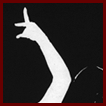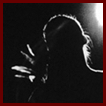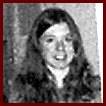 | ||||||||
... the German dance ... starts with the actual emotion expressing itself and its effect upon the individual. The distinction is one of "being" as contrasted with "doing" ... Mary Wigman ... illustrated perfectly the intimate feeling for space ... In her dances she alternately grapples with space as an opponent and caresses it as though it were a living, sentient thing ... Judy returned to Canada after graduating from the Wigman School in the summer of 1967. In these first few years she zealously pursued her solo career, even while caught up with teaching and travelling. She danced her programmes of small, highly polished solos at Kingston's Grand Theatre, Queen's University's Convocation Hall, at McMaster University in Hamilton, the University of Windsor, Hart House at the University of Toronto and she played in Berlin at the Schaubuhne Theatre in 1968. Much of her repertoire during this period had been crafted with guidance from Mary Wigman and Frau Til Thiele and included such works as Bird, Ophelia, Prophet and Trance. Every facet of the dances she did was considered. People often refer to them as jewel-like or gem-like -- they gave the sense that every surface and meaning had been carved with flawless refinement.
Judy had a big vision, which her acclaim as a solo artist only partly satisfied. From early in her performing career she desired to collaborate with artists in other disciplines and to work with a group of dancers. She wanted to build a company, and started planting the seeds for this dream. Judy met writer and director Dennis Hayes at Montreal's Instantheatre. They worked together over a number of years evolving a style of improvisation which could embrace text, movement and stimuli from the visual arts, poetry, and sometimes music. When she was invited to tour to the National Arts Centre in December of 1969, she brought dancers Gabrielle Schweiger and Carol Anderson from Queen's with her. Dennis Hayes helped her stage the show.
Dancers from that time remember sitting on the floor in a semi-circle beating on the floor, making up a ritualistic section of Tribal. Among them were Lynn Hart, Lesley Bowland, Joanne Stock, Gloria Grant, Carol Anderson, Mary Elizabeth Manley, Andrea Smith, Gillian Millard, George Sanford, Christopher Britton and Judith Davies. They were rehearsing for the September concert Visions to be performed by Jarvis and Company in September 1970 at the Toronto Workshop Productions Theatre on Alexander Street. Later that fall Judy leased a space on the top floor of 11 St. Joseph Street and opened a studio. She started commuting to the University of Waterloo to teach, while Gillian Millard, a statuesque Australian dancer, taught primitive classes and Horton technique at the studio. Gabrielle Blair taught the ballet classes, along with Gloria Grant. Judy taught modern. Frau Til Thiele returned from Germany and taught tanz gymnastik and mime. Kevin McGarrigle was also teaching at the studio. Classes cost $2.50 and were taught in the evenings and on Saturdays. In the fall of 1970 Judy and four dancers undertook the first dance tour for Prologue to the Performing Arts, performing Gypsy Journey at primary schools in Toronto and twenty-six primary schools throughout southwestern Ontario.
The Company rehearsed after the evening classes and every weekend. Judy demanded an extraordinary devotion though she gave little materially in return. She was a dedicated and serious dance artist. She was also a girlish joker, with a puckish sense of the absurd and an unpredictable black sense of humour. Judy's vision was inspiring. Her creative base included improvisation -- a challenge for the dancers and unusual for performances of that time.
Judy was scrambling to meet her financial obligations and maintain her sense of artistic independence. Looking for solitude and inspiration that winter, she went to New York to study. In March, 1971, she received a letter from her mother: Number 11 St. Joseph Street has been destroyed by fire. Your section did not fall but it will be a total loss I believe. I cannot get in as yet, but it is a godsend I put it on the insurance. It can pay the bank loan I hope! The whole thing could be a blessing for you dear. I know how you feel about it all. Your lease, etc., will all be cancelled. The fire had destroyed costumes, tapes and the studio in which Judy and her supporters had invested so much. Judy tried to come to grips with her material loss and the stifling of her professional momentum. Discouraged, she returned to New York again and again to replenish her spirit. (Next Page) ©2005, Dance Collection Danse | ||||
 The first works made by Judy Jarvis clearly show the impact of her mentor Mary Wigman. Wigman's austerity with accompaniment certainly influenced Judy's early choices of silence or the use of traditional "primitive" music for her solos. Judy liked musical textures that were porous, watery, circular. She was an early minimalist, choosing electronic music sometimes, the sounds of bells, chanting, percussion, rain -- simple music, close to the human being. As well, Wigman's exotic garments of rich textures, satin and velvet resurfaced in some of Judy's ideas about costuming.
The first works made by Judy Jarvis clearly show the impact of her mentor Mary Wigman. Wigman's austerity with accompaniment certainly influenced Judy's early choices of silence or the use of traditional "primitive" music for her solos. Judy liked musical textures that were porous, watery, circular. She was an early minimalist, choosing electronic music sometimes, the sounds of bells, chanting, percussion, rain -- simple music, close to the human being. As well, Wigman's exotic garments of rich textures, satin and velvet resurfaced in some of Judy's ideas about costuming.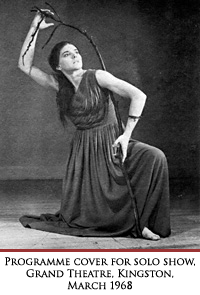 Wigman's scrupulously observed near-mystical involvement with the creative process of the Dance was laid out in her writing about dance and these books were companions of Judy's.
Wigman's scrupulously observed near-mystical involvement with the creative process of the Dance was laid out in her writing about dance and these books were companions of Judy's.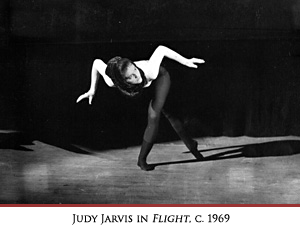
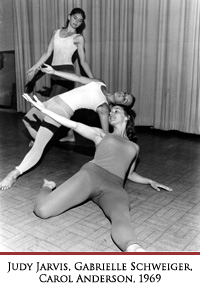 In the summer of 1970 Judy rehearsed at The National Ballet's St. Lawrence Hall studios while the ballet company was on its annual break. Judy had started to collect members of what she called a "workshop", dancers she had met at Queen's, in Toronto and in various teaching circumstances. She invited people quite casually to come and work with her, sometimes without seeing them dance. Andrea Smith recalls showing up to attend a class, and finding a rehearsal in progress, taking part. Judy invited her to join the Company at the end of the rehearsal.
In the summer of 1970 Judy rehearsed at The National Ballet's St. Lawrence Hall studios while the ballet company was on its annual break. Judy had started to collect members of what she called a "workshop", dancers she had met at Queen's, in Toronto and in various teaching circumstances. She invited people quite casually to come and work with her, sometimes without seeing them dance. Andrea Smith recalls showing up to attend a class, and finding a rehearsal in progress, taking part. Judy invited her to join the Company at the end of the rehearsal.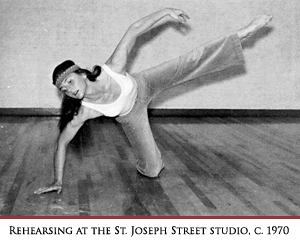
 The Company performed at York University's Burton Auditorium on January 23, 1971. Later that year, other dancers had gravitated to her work, including Gabrielle Blair and Nikki Cole. In the short time this Company had been working together they had evolved a substantial programme. Though troubled almost from the start with dissension among the Company members because of her demands, Judy's aspirations for her Company were high.
The Company performed at York University's Burton Auditorium on January 23, 1971. Later that year, other dancers had gravitated to her work, including Gabrielle Blair and Nikki Cole. In the short time this Company had been working together they had evolved a substantial programme. Though troubled almost from the start with dissension among the Company members because of her demands, Judy's aspirations for her Company were high.
